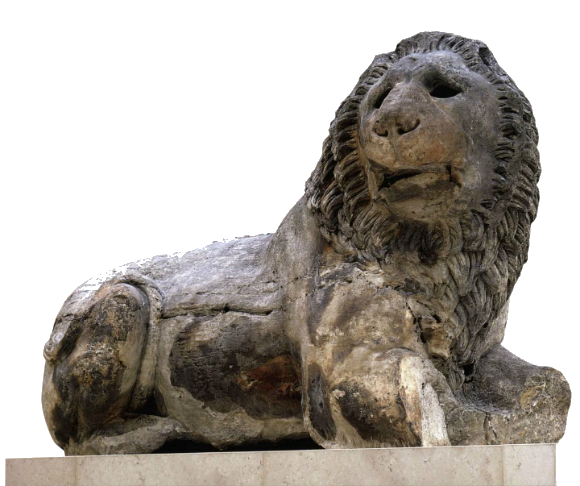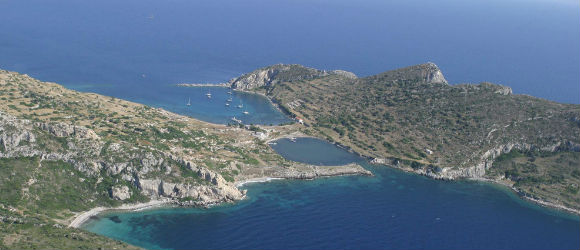The first location of Cnidus was half-way along the Datca peninsula. The residents moved it to its present site both on the Island of Tropium and on the mainland in about 365 B.C. The island is now connected to the mainland by a low, narrow isthmus which forms two small good harbors. Its citizens grew wealthy from commerce; the peninsula was famous for its wine. It was a center of culture: two theaters and an odeum suggest many hours of entertainment.
The city also had a good medical school. Praxiteles’ most famous statue, that of the nude Aphrodite, was bought by the city after the people of Cos rejected it in favor of a more modest and less celebrated woman. The original of the Cnidus statue is still being hunted; the best copy is in the Vatican Museum.
Ctesias, the Persian historian, was a native of Cnidus as was Sostratus, the builder of the Pharos at Alexandria. The Pharos was a lighthouse considered one of the Seven Wonders of the ancient world. Eudoxus, one of the great astronomers, was also born in Cnidus. He perhaps was the head of Plato’s Academy when Aristotle joined it in Plato’s absence in 367 B.C. Eudoxus had his own school later in Cyzicus. He made a map of the stars and invented the horizontal sun dial.
There were a number of temples in the city, among them ones to Dionysus and Aphrodite. Games were celebrated there in honor of Apollo and Poseidon. The agora, the Temple of Aphrodite, the odeum, and two theaters can be seen in the ruins, thanks to recent excavations.
Cnidus was the last landfall mentioned in Asia Minor in Paul’s journey from Jerusalem to Rome. He had been put on an Egyptian ship in Myra which sailed up the coast to Cnidus; because of headwinds they took a good many days to reach it (Acts 27:7). They probably did not anchor there because of the inclement weather which continued and in fact got much worse. Instead, they went on to Fair Havens in Crete where Paul advised them to winter, but, a southerly breeze springing up, the captain put out to sea again hoping for a better harbor. The wind changed and “for days on end there was no sign of either sun or stars, a great storm was raging, and our last hopes of coming through alive began to fade” (Acts 27:20).
They had run out of food before Paul saw a vision in which he was promised safe journey for himself and all on board. After two weeks they were shipwrecked, but all were saved: some swam to land, some paddled ashore on planks or parts of the broken ship. It was the island of Malta where they landed and then spent the winter. With better weather they continued on to Rome where according to tradition Paul immeasurably strenghtened the church, wrote some of his undying letters, was tried as an incendiary in the great fire during the reign of Nero, and was executed.

Knidos Lion “This colossal lion weighs some six tons. Made from one piece of marble, it was mounted on a base crowning a funerary monument. The monument itself was square with a circular interior chamber and a stepped-pyramid roof. It is a type of funerary monument inspired by the greater tomb of Maussollos, built about 350 BC”



This historical site is located just on the corner of Eagean and Mediterrenean Seas. A must see.
Referred to in the book of Acts, made it of significance to me, may not be the case for most, but the scenery getting there was awesome
This is a huge Graeco-Roman site – covers about 7 kms – and one could spend a day there exploring. Its interest is not just archaelogical and historical but also biblical. It is well-signed in English and the bonus is the wonderful views on all sides not just of the countryside but of the coast and some of the Greek…
The Datca Peninsula in the south-west corner of western Turkey provides a natural boundary between the Aegean Sea, the Gulf of Gokova to the north and the Mediterranean Sea, the Gulf of Hisarnonu to the south. Knidos lies at the tip of this long finger of land projecting into the sea. It is not the easiest place to reach as…
The agora, the theatre, an odeum, a temple of Dionysus, a temple of the Muses, a temple of Aphrodite all of them moved to famous museums of world but Knidos is still a great city.
The city, architecture of city plan and view from lighthouse all awesome.
Cons:
Food prices over average.
Enjoy the history on peninsula between Agean Sea…
A great place to visit by sailing yacht. You can charter, bareboat or skippered from Marmaris and sail the Turkish coast
Unfortunately no guides to take you round and explain different areas of the site. There were board with information but rather spaced out so not to easy the equate with the site itself.
We've visited a few historic sites in Turkey and all have been special in their own way. This was no exception. You can get there by boat but we wanted to take our time and not be restricted by a timetable so we drove from Mezgit (a pleasant 45 mins – well signposted). Beautiful route passing through villages where time…
We had a half a page description of an unmapped hike before we began our 8km journey, that included a wild dog, two cows, seaside farmers, a nomad goat shepherd family, two ruins, plenty of laugh, and a destination…. For me, once a city girl:) it turned out to be one of the greatest pleasures of my lifetime…. During which…
Really nice quiet place with no crowds and lots to see. You're able to walk/climb freely through all the ruins and really get a feel for how it must have been. As the site is still actively being worked on, you are also able to watch people cleaning and restoring parts of the ruins.
Make sure your camera has a…